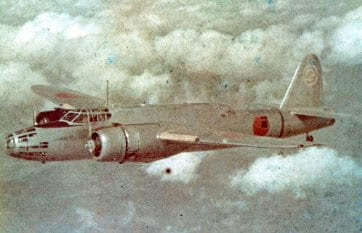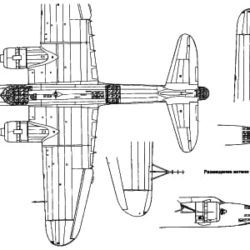Nakajima Ki-49 Donryu History
The Nakajima Ki-49 Donryu was intended as a much-needed replacement for the aging Mitsubishi Ki-21 Sally. However, it conferred few advantages in terms of performance, and most crews actually preferred the older machine.
Deployment of the Mitsubishi Ki-21 bomber had no sooner begun in 1938 than the Japanese army began contemplating its successor. That year the army staff drafted specifications for a new aircraft featuring crew armor, self-sealing tanks, and the first-ever tail turret mounted in an army bomber. Nakajima, which had earlier lost out to Mitsubishi and ended up producing Ki-21s under license, gained firsthand knowledge about their competitor’s product and sought to improve upon it.
The first prototype Nakajima Ki-49 Donryu was flown in August 1939, having been designed to a Japanese Army Air Force (JAAF) specification issued at the end of the preceding year. It was followed by a second prototype, each being powered by Nakajima Ha-5B engines. The prototypes proved less than 20 mph (32 km/h) faster than the Ki-21, had a poor operational ceiling and were armed only with a single 20 mm cannon and two 7.92 mm machine-guns. Some improvement was made in subsequent prototypes, and in the Ki-49-I Model 1 which entered production in the late spring of 1940, by installing 1,250 hp Ha-41 engines. One hundred and twenty-nine Ki-49-Is were built at Ota and the name Donryu was bestowed by the manufacturer, after the well-known Shinto shrine there. (A colloquial translation of Donryu is ‘Dragon Swallower’.)
In the Allied coding system the Nakajima Ki-49 Donryu was known as ‘Helen’. The Ki-49-IIa, the next production version, had three additional 7.92 mm guns; in the Ki-49b all five machine-guns were of 12.7 mm calibre. Six hundred and forty-nine Ki-49-IIs were built by Nakajima, fifty by Tachikawa and a small number by Mansyu. The parent company also completed six examples of Ki-49-III, with 2,500 hp Ha-117 engines, but this version was not developed, and production of the Donryu ceased in December 1944.
First operational appearance of the Ki-49-I was on 19 February 1942, when a force of them attacked Port Darwin in Australia from New Guinea. The Ki-49-II, which entered service in the following September, was encountered in the China-Burma-India theatre, the Netherlands East Indies, Formosa and Philippines. After the Leyte Island campaign, in which many where lost, they were extensively used for suicide attacks, though some were employed for mine detection and coastal patrol. A Nakajima Ki-49 Donryu, carrying Emperor Hirohito’s envoy to Okinawa to sign the surrender agreement on 19-20 August 1945, made the last flight of the war by a JAAF aircraft. Such was the insistence on engine power and defensive armament that the Ki-49 inevitably suffered from having small bomb load and inadequate range.
Three Ki-58 fighter prototypes, based on the Ki-49-IIIs were converted as formation leaders with the designation Ki-80.










